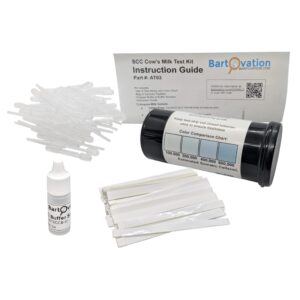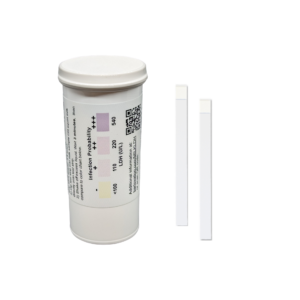Description
This reliable on-farm test can be used to detect subclinical ketosis in individual cows before it progresses and causes both harm to your cows and profits. This test specifically tests and quantifies BHB, a common ketone that is formed during subclinical ketosis.
This semiquantitative dipstick test can simply be dipped into fresh foremilk, shaken, and compared to the provided color chart after just one minute.
Instructions for use:
- Normal udder prep procedure prior to milking (usually involves cleaning, disinfection, specific wait time prior to applying milking units for letdown).
- Strip each quarter 3-5 x or whatever the farm’s procedure is for initial milk discard,
- After the initial discard stripping, use test as directed, where users can either strip milk directly onto the test pad or dip the test into a vial of milk (testing quarters or a composite sample from a vial),
- Shake off excess milk, and
- Compare test strip to color chart according to instructions.
Note: Avoid using test strips that have discolored after extended storage. The reagent pad on unused test strips should be yellow.
Interpretation of results:
| BHB Concentration in milk |
Indication |
| 0-99 μmol/L |
Normal (-) |
| 100-199 μmol/L |
|
| 200-499 μmol/L |
Positive (+) |
| 500+ μmol/L |
|
Learn more about the different methods for testing dairy cows for clinical and subclinical ketosis and the pros and cons of each.
This test is intended solely for the estimation of ketones in fresh cow milk. The test is not a laboratory reference method and should not be used as a diagnostic test. Consult a veterinarian before starting any treatment. This test is not intended for use on humans. Bartovation products are not approved for use as medical devices. Products and product information is for informational purposes only and not intended for use to diagnose, treat, cure or prevent any medical condition. Consult a medical doctor when needed.
Frequently Asked Questions (FAQ)
Why is testing for subclinical ketosis important? Monitoring for sub-clinical ketosis is vital because it allows for early detection and treatment before clinical signs appear, such as a foul odor on a cow’s breath. Sub-clinical ketosis is far more common than clinical ketosis and leads to significant economic losses due to decreased milk production, impaired fertility, displaced abomasums, and metritis. Each case of ketosis can cost approximately $150 and may result in 506 lbs of milk loss per affected cow. It also causes 0.5% death loss and can lead to 5% of affected cows being culled. Monitoring at the herd level helps producers identify and correct nutritional and other ketosis-related management issues. Ultimately, healthier cows lead to better milk quality, increased production, and higher profits.
When should I check cows for BHB levels? For best results, do not check cows for BHB level within four hours after feeding, or right after they have eaten. Instead, sample cows as they are coming into the feeding stalls. Cows should generally be monitored for BHB at 2 to 14 days in milk, as this is when the incidence of sub-clinical ketosis peaks; this period may extend to 21 days.
What are the suggested protocols for individual cow management? A recommended protocol is to test all fresh cows once a week during the first two weeks of lactation; this identifies approximately 95% of sub-clinical cows. Alternate protocols include testing all fresh cows once during the second week of lactation, which identifies about 69%–86% of sub-clinical cows. You might also consider focusing on fresh older cows (second or greater lactation), fresh cows with a body condition score greater than 4, or fresh cows during periods of heat stress. For problem herds experiencing an abnormal incidence of displaced abomasums, metritis, mastitis, weight loss, or poor milk production, it’s advised to test all fresh cows weekly for the first six weeks of lactation.
What are the suggested protocols for herd level management? For dry cow and transition periods, monitor cows two weeks after freshening. If two or more cows test positive, it is recommended to consult with your veterinarian and/or nutritionist to evaluate herd management practices during these periods. For general herd health and nutrition management, you can check 12 cows in each feeding group quarterly. If two or more cows test positive, consult with your nutritionist to evaluate herd feed rations. Factors that often influence the incidence of ketosis include feed bunk space, overcrowding, heat stress, and transition diets.
How does this test compare to other methods for detecting ketosis? This test offers immediate results at a lower cost compared to laboratory tests. While the gold standard for detecting sub-clinical ketosis measures BHBA in serum using lab tests, which typically measure BHB in blood serum or plasma, most ketosis powders and urine dipsticks are less specific for sub-clinical ketosis because they change color in the presence of other ketones, not primarily BHB. Common threshold values for on-farm testing of subclinical ketosis are 100 µmol/L to 200 µmol/L for milk BHB, compared to 1200 µmol/L to 1400 µmol/L for blood BHB.
What is this test used for? This test is used for the screening of cows for sub-clinical ketosis. It allows for cow-side subclinical ketosis screening, enabling early detection. It can be used for monitoring fresh cows and checking herd level nutritional status. The test helps detect subclinical ketosis in individual cows before it progresses and causes harm or profit losses. It is intended solely for the estimation of ketones in fresh cow milk.
What does this test detect? This is a semi-quantitative dipstick test designed to detect subclinical ketosis. It specifically tests and quantifies beta-hydroxybutyrate (BHB), which is a common ketone formed during subclinical ketosis. High levels of BHB indicate ketosis, a metabolic disorder resulting from a negative energy balance.
How does the test work? The test is a semi-quantitative milk dipstick. It operates based on a chemical reaction between an enzyme on the test strip and BHB found in the milk. This reaction causes the test strip’s sample area to change to a purple color. The darker the purple color, the higher the concentration of BHB.
How do I use the test? You can simply strip milk directly onto the test pad or dip the test into a vial of fresh milk. First, perform the normal udder preparation procedure prior to milking. After the initial discard stripping (3-5 times per quarter or following your farm’s procedure), apply the test. After applying milk, shake off any excess. Wait just one minute, then compare the color change on the test strip to the provided color chart. If you collect a milk sample into a container, the container does not need to be sterile, but the sample should be mixed thoroughly before testing. If milk or test strips have been refrigerated, allow them to reach room temperature before testing. Milk should be tested within 24 hours of sampling.
How quickly do I get results? You will get results in one minute.
What are the storage requirements for the test strips? No refrigeration is required for the test strips. It is crucial to keep the strip vial tightly closed as test strips are moisture sensitive. Avoid using test strips that have discolored after extended storage; the reagent pad on unused test strips should be yellow. Do not touch the reagent pad on the test strips. If test strips appear pink or purple due to exposure to direct sunlight or high humidity, they should be discarded.
What is the shelf life of the product? The product has a two-year shelf life from the date of manufacture when stored at room temperature.
How do I interpret the results? After one minute, compare the test strip to the provided color chart. The interpretation based on BHB concentration in milk is as follows:
- 0-99 μmol/L: Normal (-)
- 100-199 μmol/L: Weak Positive (+/-) or questionable (+/-)
- 200-499 μmol/L: Positive (+)
- 500+ μmol/L: Highly Positive (++)
For herd level management of hyperketonemia, researchers suggest a threshold of 100 µmol/L (University of Montreal). For individual cow detection of sub-clinical ketosis, a threshold of 200 µmol/L is suggested due to its excellent specificity.
What are the recommended testing temperatures for samples? It is recommended to test milk samples in an environment where the temperature is between 8˚C and 35˚C (65˚F — 95˚F). If the milk has been refrigerated, allow it to warm to room temperature before testing.
Can this test be used for other animals like goats or sheep? No, this test has not been field-tested in dairy goat and sheep samples. It is designed for use with milk from cows only, and results with other fluids have not been studied.
Can I test milk samples containing antibiotics or hormones? Yes, antibiotics will not interfere with the test. Similarly, hormones in the milk do not impact BHB test results.
What about samples with preservatives? If the preservative in a milk sample contains a colored dye, it may change the color of the test strip and affect the results.
What are the limitations of this test? This test is intended solely as an on-farm screening test for the estimation of ketones in fresh cow milk. It is not a laboratory reference method and should not be used as a diagnostic test. You should consult a veterinarian before starting any treatment. The test is not intended for use on humans, and these products are not approved for use as medical devices. Additionally, mastitic cows or cows with high Somatic Cell Counts (SCC > 1,000,000) may exhibit higher BHB levels.

![Milk Ketone Test for BHB in Cow Milk [Vial of 50 Strips]](https://bartovation.com/wp-content/uploads/2023/09/BHB-main-image-1.png)
![Milk Ketone Test for BHB in Cow Milk [Vial of 50 Strips] - Image 2](https://bartovation.com/wp-content/uploads/2023/08/PXL_20230830_173334258.png)
![Milk Ketone Test for BHB in Cow Milk [Vial of 50 Strips] - Image 3](https://bartovation.com/wp-content/uploads/2023/09/PXL_20231128_195845055.png)
![Milk Ketone Test for BHB in Cow Milk [Vial of 50 Strips] - Image 4](https://bartovation.com/wp-content/uploads/2023/08/PXL_20230830_173414852.png)


Reviews
There are no reviews yet.